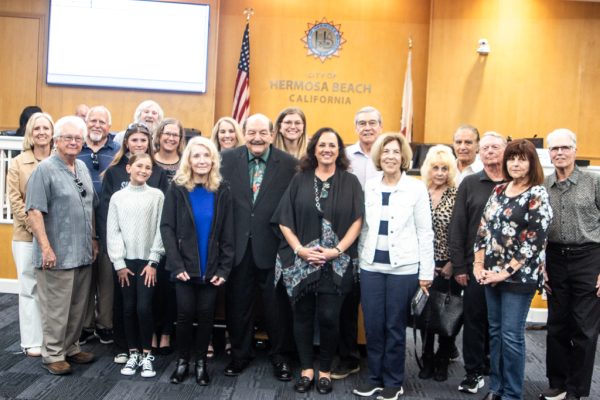by Garth Meyer
If you flew out of LAX in late 2021 on Delta Airlines, chances are your plane burned fuel that was half petroleum-based and half soybean oil. It came from Chevron’s El Segundo refinery.
Since then, Chevron El Segundo has expanded its biofuel production. It now supplies 100% renewable soybean oil truck diesel, known as R99, to its Southern California gas stations.
“We’re supplanting crude oil with vegetable oil,” Chevron El Segundo Corporate Affairs Manager Jeff Wilson said at a November 3 press event.
Soybean oil arrives at the refinery by rail and feeds into a “diesel hydrotreater.” Its spindly distillation columns and pressure vessels cover more than an acre. The soybean oil mixes with a proprietary pellet, causing a chemical reaction that converts it to diesel fuel.
El Segundo has made more than 20 million gallons since August.
“We’re taking a soybean molecule and converting it to a finished diesel molecule in a reactor,” said Steven Johnson, diesel hydrotreater project manager. “We’ve fueled up a lot of trucks in 100 percent renewable diesel.”
CO2 emissions are cut by up to 47%, according to the Environmental Protection Agency, compared to standard diesel.
“It’s been many, many years in the making,” Wilson said.
In February 2022, Chevron bought Renewable Energy Group, Inc., headquartered in Ames, Iowa, for $3.15 billion.
“It’s a big deal,” Wilson said. “It launched Chevron into being the second largest renewable energy company in America.”
Renewable Energy Group (REG) had a growing renewable fuels production business, recognized for its feedstock capabilities.
Chevron’s goal is to produce 100,000 barrels per day in renewable fuels by 2030.
The cost of a gallon of R99 is the same as diesel, though soybean oil is more expensive than crude oil. Chevron is incentivized under the California Low Carbon Fuel Standard.
Wilson said the soybean-based fuel is superior to ethanol, made from corn.
“Ethanol was an early attempt. This takes it to a new level,” he said. “It’s not competing with a food crop or animal feed. And it’s readily available and easy to grow.”
“We can produce this in larger quantities than ethanol,” said Fredrick Walker, El Segundo refinery director.
“Chevron Way”
Chevron El Segundo announced this summer that it can scale up its production to commercially produce jet fuel that is half soybean oil.
“We have the agility to manufacture a range of products based on market demand,” Wilson said.
“We’re very proud of these advancements,” Walker said.
He talked about the “Chevron Way.” “Our values and our actions and our aspirations to deliver on our goals.”
Also speaking under a tent on the sunny morning of Nov. 3 at Chevron Employees Park, was Andy Walz, president of Chevron America’s Products, who is based at the company’s San Ramon headquarters.
“If I leave you with one thing, it’s ‘Hey, Chevron is part of the solution,’” he said. “Electricity is going to be a solution. That’s fine. We can be part of the solution, too. These kinds of problems need all kinds of solutions.”

“We had not thought of this three years ago,” he said of the 100 % renewable diesel. “We believe our future products have to be lower carbon. Our competitors have to do it. Everybody has to do it to make this work.”
Noting that Chevron is the “second largest biofuel producer in the U.S.,” he told the gathered,
“We aspire to be (at the top)… If (biofuels) were cheaper, we’d have done it already.”
Repurposed infrastructure
El Segundo diesel engineers worked with one of the refinery’s existing reactors to make R99.
“We’re re-using the bulk of infrastructure we already have. It was a very quick turnaround to get up and going in renewable,” Johnson said.
To make the new diesel and jet fuel, the refinery expanded railcar mechanisms (offloading racks), to pump the soybean oil into 100,000 barrel-sized tanks.
The soybean oil comes from mostly the midwest.
“What we’re most proud of on this project are no safety incidents, no environmental impacts, and no community impacts,” Johnson said.
How does he know?
“Because Jeff (Wilson) didn’t call me,” he said.
Community impacts would include noise and odor complaints.
“The big focus now is to continue to run safely and reliably,” Johnson said.
Chevron developed the new products in conjunction with its longstanding El Segundo community advisory panel.
El Segundo is the first U.S. refinery to co-process vegetable oil in a fluid catalytic cracking unit.
“Affordable, reliable and ever-cleaner energy,” Walker said of Chevron’s lower carbon initiatives. “We know we can scale it up for the future.”
Drawbacks?
The International Council on Clean Transportation and other climate watchers have expressed concern that more soybean oil used for fuel means food manufacturers will buy more palm oil from Asia, which could lead to deforestation – and higher greenhouse gas emissions from palm oil plantations.
They say this could cancel out progress made from biofuels.
Deforestation increases carbon dioxide in the atmosphere.
“We don’t have a comment on Chevron specifically, but the move to renewable fuels is critical to California’s shift away from fossil fuels,” said Dave Clegem, California Air Resources Board public information officer, climate change programs. “Renewables will provide the transportation fuels that allow us to make a measured transition from internal combustion vehicles to those needed to achieve carbon neutrality by 2045.”
Clegem noted that when the Air Resources Board evaluates a fuel, it undergoes a life-cycle environmental analysis of each step in its production.

“(In September) the board directed staff to … include further sustainability requirements to avoid issues such as deforestation,” Clegem said. “The life cycle approach for accounting includes land use-change factors that already disincentivize (environmentally-damaging activities). While this has not presented itself as an issue to date, the sustainability requirements could add more guardrails to protect against any future potential for this outcome.”
“We use non-food grade soybean oil,” Wilson said, noting that other fuel sources such as canola oil and tallow may be tapped in the future. “The fact remains that biofeedstocks have been used for over a decade. State and federal regulations have promoted and incentivized the use of feedstocks to reduce carbon (output).”
This fall, five of the world’s largest oil companies, including Chevron, were sued by the State of California, led by Governor Newsom and Attorney General Rob Bonta, alleging the defendants long knew fossil fuels were causing climate change, and were engaged in “decades of deception” to protect profits at the expense of the environment.
Chevron El Segundo produces 20 percent of the fuel in greater Los Angeles, and 40 percent of the jet fuel at LAX. The complex is the company’s second largest in the U.S.
Chevron’s renewable fuels operation, “Renewable Fuels – REG” is now headquartered in Ames, Iowa, where REG was based. Before the sale, REG operated 11 biorefineries in the U.S. and Europe.
“We’re disappointed with the political posturing of some in California,” Wilson said. “We’re just continuing to focus on our renewables and let our actions speak louder than the narrative.” ER











